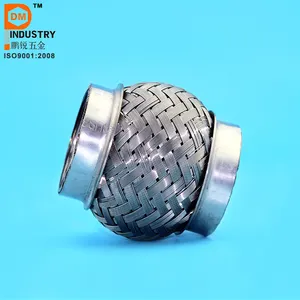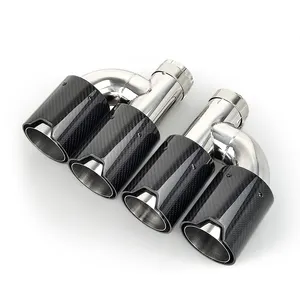An H pipe is a critical component in automotive exhaust systems, specifically designed to balance the exhaust gases and pressure between two sides of a dual exhaust system. This balance can lead to improved performance, reduced noise, and a distinctive sound that is highly sought after by automotive enthusiasts. The H pipe connects the exhaust pipes of both sides through a cross-section that resembles the letter "H", hence its name.
Types and Characteristics of H Pipes
Diving deeper into the types of H pipes, we find a variety of designs tailored to different vehicle models and performance needs. For instance, the foxbody H pipe is specifically designed for the iconic Ford Mustang models from the late '70s to the early '90s, known as the Foxbody generation. On the other hand, the universal H pipe offers a more flexible solution that can be adapted to a wide range of vehicles, making it a popular choice for custom builds or less common models. High-performance vehicles, such as the Mustang GT, may opt for a Roush H pipe or a BBK H pipe, which are designed to enhance the aggressive sound and improve exhaust flow for better engine output. Each type of H pipe brings its own set of characteristics, such as the 3 inch H pipe which provides a larger pathway for exhaust gases, suitable for engines with a higher displacement.
Structure and Operation of H Pipes
The structure of an H pipe is a marvel of engineering, designed to seamlessly integrate with the existing exhaust system. It consists of two parallel pipes connected by a perpendicular cross pipe, which forms the characteristic 'H' shape. This design allows exhaust gases to flow freely between the two sides, equalizing pressure and enhancing the scavenging effect. The strategic placement of the cross pipe is crucial as it determines the point at which the exhaust pulses will interact, affecting the sound and performance of the vehicle. The H pipe works in conjunction with other exhaust components, such as mufflers and catalytic converters, to optimize the vehicle's exhaust system.
Materials and Properties
The materials used in the construction of H pipes are selected for their ability to withstand high temperatures and corrosive exhaust gases. Stainless steel and 304 stainless steel are commonly used due to their corrosion resistance and strength. These materials ensure that the H pipe can endure the harsh conditions of an exhaust system without degrading. The properties of stainless steel, such as its thermal expansion rate and acoustic qualities, also contribute to the performance and durability of the H pipe, making it an ideal choice for both everyday vehicles and high-performance applications.
Business Usages and Applications
In the business realm, H pipes are utilized in various industries where vehicles play a pivotal role. In the construction industry, heavy machinery benefits from the improved exhaust flow, leading to better fuel efficiency and reduced operational costs. Automotive repair shops and custom car builders use H pipes to upgrade exhaust systems for enhanced performance and sound quality, creating value for their customers. The retail sector also sees a demand for H pipes among car enthusiasts looking to personalize their vehicles, thus driving sales of aftermarket exhaust components.
Functions of H Pipes
The primary function of an H pipe is to balance the exhaust pressure between the two sides of a dual exhaust system. This balance is crucial for the smooth operation of the engine, as it allows for equal exhaust flow, reducing back pressure and improving horsepower. Additionally, the H pipe contributes to the reduction of exhaust noise, creating a more pleasant driving experience. It also plays a role in the thermal management of the exhaust system by evenly distributing heat across both sides.
Features and Unique Selling Points
One of the distinct features of an H pipe is its ability to create a deeper, more resonant exhaust note, which is a unique selling point for many car enthusiasts. The design of the H pipe also allows for a degree of customization, with options such as the 2.5 H pipe or the 3 H pipe, catering to different engine sizes and performance requirements. The use of high-quality materials like 304 stainless steel not only ensures durability but also adds a visual appeal to the vehicle's undercarriage.
Benefits and Positive Outcomes
The installation of an H pipe brings multiple benefits, including improved engine efficiency, potential increases in horsepower and torque, and a more attractive exhaust sound. These improvements can lead to a more enjoyable driving experience and potentially better fuel economy. For businesses, the use of H pipes can result in lower maintenance costs due to the durability of the materials used, as well as customer satisfaction from the noticeable enhancements in vehicle performance.
How does an H pipe enhance vehicle performance?
An H pipe enhances vehicle performance by improving exhaust scavenging, which is the removal of spent gases from the combustion chambers. This leads to a more efficient engine cycle and can result in increased horsepower and torque. The design of the H pipe allows for a smoother flow of exhaust gases, reducing back pressure and improving the overall efficiency of the exhaust system.
What considerations should be made when selecting an H pipe?
Selecting the right H pipe involves considering the vehicle's make and model, the desired performance outcome, and the compatibility with existing exhaust components. For example, a universal H pipe may offer a more flexible solution for diverse applications, while a model-specific foxbody H pipe or gt350 H pipe might provide a more tailored fit and performance. The material, size, and alloy composition are also critical factors that will influence the pipe's performance and longevity.
How can one ensure the longevity of an H pipe?
Ensuring the longevity of an H pipe involves regular maintenance checks for signs of wear, such as rust or cracks, particularly in harsh driving conditions. Proper installation is also key; an improperly fitted H pipe can lead to leaks or damage. Using the correct grade of stainless steel for the specific application will also play a significant role in the durability of the pipe. For instance, a 3 H pipe made from 304 stainless steel is likely to last longer than one made from a lower grade material.




































 浙公网安备 33010002000092号
浙公网安备 33010002000092号 浙B2-20120091-4
浙B2-20120091-4